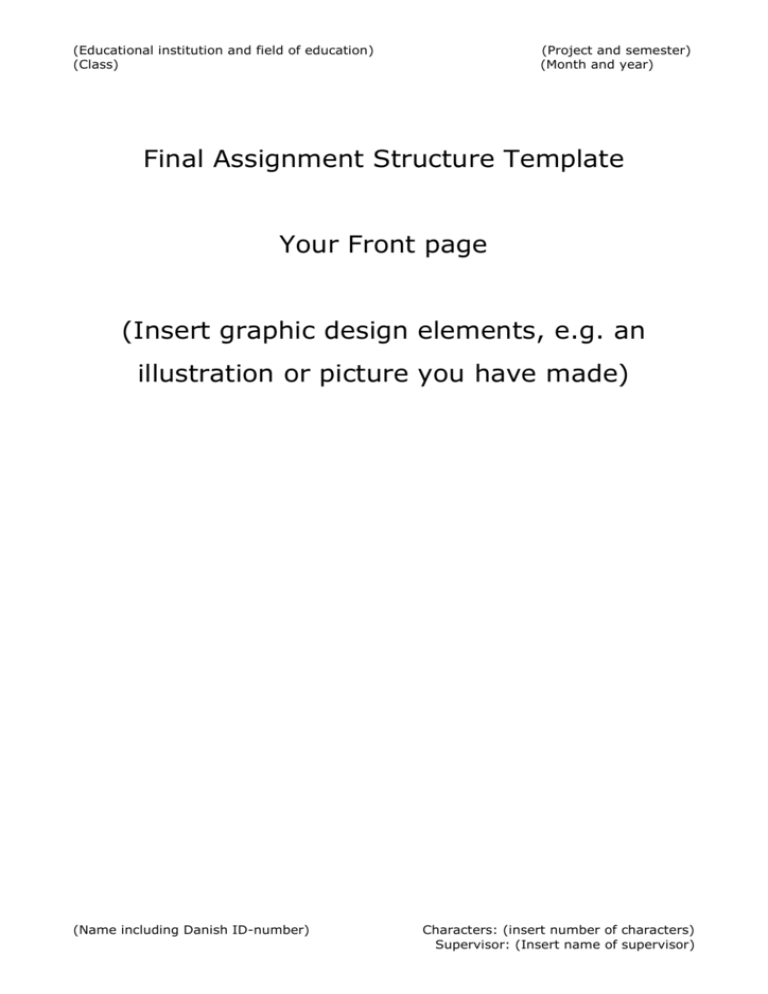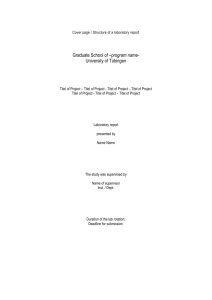1.3 Assignment structure - Det Gyldne Overblik
advertisement

(Educational institution and field of education) (Class) (Project and semester) (Month and year) Final Assignment Structure Template Your Front page (Insert graphic design elements, e.g. an illustration or picture you have made) (Name including Danish ID-number) Characters: (insert number of characters) Supervisor: (Insert name of supervisor) (Educational institution) (Project + titel) (Logo if any) The table below should be the second page of your assignment, following your front page PRESCRIBED FRONT PAGE NAME: (If writing in groups, please state names of all group members) Danish ID-Number (If writing in groups, please state ID-numbers of all group members) Student Exam No.: (6 digit No at your Student ID-card called either Kortnr. or Eksamensnr.) Class No. E.g.: U02 COURSE/EXAM TITLE: NAME OF SUPERVISOR: NUMBER OF CHARACTERS IN YOUR ASSIGNMENT: (eksklusive of blanks) (Field of education) (Semester – Month and yearl) (Educational institution) (Project + titel) (Logo if any) Abstract This purpose of this section is for you to give a brief overview of your entire assignment. In typically maximum 1 page, you should summarize: Topic and problem statement Your chosen theory/theories Method The three (taxonomic) levels Results Conclusions and recommendations (Field of education) (Semester – Month and yearl) (Educational institution) (Project + titel) (Logo if any) Table of contents Abstracts ....................................................................................................Error! Bookmark not defined. 1. Introduction ............................................................................................................................................. 1 1.1 Problem statement ......................................................................................................................................... 1 1.2 Delimitation....................................................................................................................................................... 1 1.3 Assignment structure..................................................................................................................................... 1 2. Method ....................................................................................................................................................... 2 2.1 Theory of science (Bachelor level only) .................................................................................................. 2 2.2 Research design (Bachelor level only) .................................................................................................... 2 2.2.1 Purpose of research................................................................................................................................................... 2 2.2.2 Time frame .................................................................................................................................................................... 2 2.2.3 Approach of research and strategy ..................................................................................................................... 2 2.2.4 Methods of research .................................................................................................................................................. 2 2.2.5 Research guide and sampling ................................................................................................................................ 2 2.3 Secondary literature ...................................................................................................................................... 3 2.4 Choice of theory and model ......................................................................................................................... 3 2.5 Source criticism................................................................................................................................................ 3 3. The descriptive level ............................................................................................................................. 4 4. The analytical level ................................................................................................................................ 5 5. The evaluative level .............................................................................................................................. 6 6. Discussion ................................................................................................................................................. 7 7. Conclusion ................................................................................................................................................ 8 8. Implications of findings ....................................................................................................................... 8 9. Bibliograpy ............................................................................................................................................... 9 10. Appendixes ......................................................................................................................................... 10 (Field of education) (Semester – Month and yearl) (Educational institution) (Project + titel) (Logo if any) 1. Introduction The introduction is the bridge that leads the reader into your assignment. It is the primary purpose of this section to capture the reader’s attention and encourage him/her to read more. An introduction with a convincing history, a fascinating quote or a good example are among the elements you can consider to include in the introduction. Furthermore, your introduction should include the sections: problem statement, delimitation and assignment structure. 1.1 Problem statement The purpose of the problem statement is to pose the specific questions you are to answer throughout your assignment. The problem statement is key because it steers the assignment and it is therefore paramount that it is thought-through and precise, plus well constructed. Begin with a brief introduction followed by an overarching question. After that, you should write one or more descriptive, analytical and evaluative subquestions which serve to ensure that you can answer the overarching question at the end of your assignment. 1.2 Delimitation Specify reservations in your assignment; in other words, which aspects (among these, theories and models) you have chosen not to include. Remember to make your case for your choices. 1.3 Assignment structure In this section you are to guide your reader through your assignment and explain why and how it is constructed the way it is. Make sure that the section brings relevant information to the table and thus is not just a repetitive of the table of contents. (Field of education) (Semester – Month and year) Page 1 (Educational institution) (Project + titel) (Logo if any) 2. Method A scientific method is a systematic procedure which can be explained so the reader will be able to follow (and able to replicate) your research by using your procedure. The method of your section should include the sections: theory of science, research design, secondary literature, choice of theory and model and source criticism: 2.1 Theory of science (Bachelor level only) Your choice of scientific theoretical approach determines how you construct knowledge in your assignment based on your assumptions of the world (ontology) and your way of perceiving the world (epistemology). Different approches thus result in different types of generating knowledge, including which methods one can use to collect data and how one is to process these data. 2.2 Research design (Bachelor level only) The research design is the combination of procedures you use when collecting, analyzing and interpreting data. In this section you should explain your: 2.2.1 Purpose of research o Exploratory, descriptive or explanatory research 2.2.2 Time frame o Cross sectional study or longitudinal study 2.2.3 Research approach and strategy o Inductive or deductive o Experiment, survey, case study, action research, grounded theory, ethnography or archive research 2.2.4 Methods of research o Interviews, questionnaire, observations or a mix 2.2.5 Research guide and sampling o Summary of your interviewguide, questionnaire guide or observationguide (Field of education) (Semester – Month and year) Page 2 (Educational institution) (Project + titel) o (Logo if any) Choice of sampling method (randomized or non-randomized sampling) 2.3 Secondary literature Explain your choice of secondary literature. Are you using archives, multiple sources, surveys or a mix? 2.4 Choice of theory and model Concisely explain the theories and models you are using in your assignment. Example: Title of your model: o Which model is it and who has created it? o Why have you chosen it and in which ways is it helpful? o Opting in/ opting out (e.g. Why PEST instead of PESTEL or the other way around) o Critique of the model 2.5 Source criticism In this section you are to critize your theories, models and models used to analyze, including the reliability and validity of your sources. Make sure to specify what the criticism is about, and remember to argue professionally and objectively. (Field of education) (Semester – Month and year) Page 3 (Educational institution) (Project + titel) (Logo if any) 3. The descriptive level The section where you describe, explain, depict and characterize. Writing on the lowest academic level, your goal is to introduce the reader to your assignment. Make sure to answer the descriptive sub-question(s) from you problem statement. Additionally, you should keep in mind that this part of your assignment should take up the least amount of space possible. (Field of education) (Semester – Month and year) Page 4 (Educational institution) (Project + titel) (Logo if any) 4. The analytical level Writing on this middle academic level you are to analyze and compare, based on your collected data. Make sure that you answer the analytical sub-question(s) from your problem statement. This section can take up a significant part of your assignment. (Field of education) (Semester – Month and year) Page 5 (Educational institution) (Project + titel) (Logo if any) 5. The evaluative level The highest academic level! In this section you are to discuss and evaluate. Make sure to give the reasons for your assessments and, additionally, to take a critical view of your own assignment and the applied theory. (Field of education) (Semester – Month and year) Page 6 (Educational institution) (Project + titel) (Logo if any) 6. Discussion In this section you are to discuss and critize your own theory, method and results. It shows that you are able to put your assignment into perspective, which is usually rewarded gradewise! Which theories have you given an account of, and what are their strong and weak sides? Which different perceptions and arguments do your chosen theorists have? Try to compare them and highlight the strong and weak points. In which areas is your chosen method solid, and where are its limitations? What can you say about the results you have reached? (Field of education) (Semester – Month and year) Page 7 (Educational institution) (Project + titel) (Logo if any) 7. Conclusion In the conclusion you address the questions or the problem you put forward in the problem statement section. As a rule of thumb, the reader should be able to read the problem statement and jump straight to the conclusion and be able to get the answers! The conclusion does not have to be a final answer, since it is possible that you have not reached one In other wrods, it can consist of an elucidation of the problem statement and include diverse ascertainments and recapitulations Cannot introduce anything new (/any new information)! Go through your assignment and sum up, without going to much into details, the most important points and circumstances 8. Implications of findings Put your results, conclusions and assessments from your assignment. Try to view your assignment in a larger perspective and look into the future: What conclusions have you reached in your assignment that are particularly relevant within your field or in society as a whole? Is your assignment changing a prevailing perception of e.g. your topic? Which areas (theories, models, tables) did you not include in your assignment that could be relevant in future researchs? Take a look at your delimitation section for help to write this part! (Field of education) (Semester – Month and year) Page 8 (Educational institution) (Project + titel) (Logo if any) 9. Bibliography State the literature and any other sources you may have made use of throughout your assignment. Is always listed alphabetically with the author’s lastname first. In the list of books, the author(s) name(s), title, year of publication, edition, place of publication and publishing company. Example of how to list a book (note how the title is in italics): Andersen, Ib (2009). The reality of science (fourth edition). Frederiksberg C: Samfundslitteratur. (Field of education) (Semester – Month and year) Page 9 (Educational institution) (Project + titel) (Logo if any) 10. Appendixes Appendixes constitute the very last part of your assignment and consist of material that, of practical reasons, e.g. out of regard for form and size, you have not included in the actual assignment. The appendix pages are counted/included in the total number of characters of your assignment. Appendixes are only included if they help document something you have written in the assignment. Examples: Questionnaire Transcription of an interview or video clip Models and figures Calculations The appendixes have to be numbered and it also have to be apparent from the title of the appendix what it is about. Example: Appendix 1: Quessionnaire for employees at LEGO, 10/11/2015 (Field of education) (Semester – Month and year) Page 10




